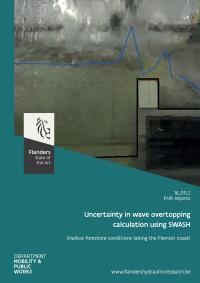Gedaan met laden. U bevindt zich op: Uncertainty in wave overtopping calculation using SWASH. Shallow foreshore conditions (along the Flemish coast)
Uncertainty in wave overtopping calculation using SWASH. Shallow foreshore conditions (along the Flemish coast)
Offshore wave boundary conditions often consist of energy density spectra being readily available (e.g. offshore wave buoys) or idealized energy density spectra of which the parameters are reported (e.g. in the Hydraulic Boundary Condition book, De Roo et al., 2016). In numerical modelling, an infinite number of surface elevation time series can be generated out of one energy density spectrum by linearly superposing the spectral wave components, of which the phases are assumed to be randomly distributed. To create randomly varying phase components, an input seed number is needed. By varying this seed number for every simulation, a different surface elevation time series, i.e. different wave train, will be created.
The number of waves overtopping a structure is governed by the number of large wave heights in the wave train and the specific sequence of waves arriving at the structure. Hence, random wave trains resulting from the same energy density spectrum, lead possibly to different volumes of waves that overtop and introduce variability in the numerically estimated wave overtopping discharge.
To assess this variability in wave overtopping, 500 simulations were carried out for every case. In total, 18 cases were identified by categorizing the Flemish coastline into 6 generalized bathymetric configurations, varying in cross shore profile, in foreshore length, in presence of a steeper part in its slope closer to the dike and ending in a dike, have a 1:2 slope and 3 different crest levels.
Given that wave overtopping discharge is accepted to be normally distributed, its mean result and the variability around this value can be assessed by its relative error. The higher the mean wave overtopping discharge, the lower the relative error becomes (power law relation). Indeed, the higher the freeboard, the smaller the probability of overtopping, and hence, the more wave overtopping depends on the individual wave characteristics in the surface elevation time series. Translating this fitted relation to a confidence band around the mean indicates that 68.3% of the wave overtopping values are captured within ± 1 standard deviation around the mean. The upper confidence limit, generally used for design and assessment purposes, adds some safety to the mean result, and hence, the mean wave overtopping result needs to be increased by its associated standard deviation to account for seed number variability.
In practice, it is not possible to carry out that amount of simulations to determine the wave overtopping discharge. Applying both a Monte Carlo and data sampling approach, the added uncertainty was quantified given that only a reduced sample of 1 to 20 wave overtopping estimates is used instead of 500. As from a sample size of 8, the added accuracy gained by increasing the sample size becomes insignificant compared to the calculation effort of doing extra simulations. Therefore, a sample size of 8 is opted for.
To conclude, wave overtopping discharge needs to be estimated by at least 8 SWASH 1D simulations. Their mean result is then the wave overtopping discharge on which for seed number selection and sample size uncertainty needs to be accounted for, in order to obtain a final numerical estimate of the wave overtopping discharge.

Lees de publicatie
- Publicatiedatum
- Januari 2020
- Publicatietype
- Onderzoeksrapport
- Thema's
- Scheepvaart en havens
- Auteur(s)
- S. De Roo, T. Suzuki, C. Altomare, F. Mostaert
- Reeks
- FHR reports